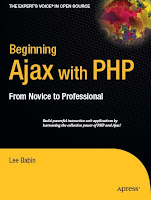
Chapter 2: “Ajax Basics,” moves you from the why to the what, covering fundamental Ajax syntax and concepts that will arise no matter the purpose of your application.
Chapter 3: “PHP and Ajax,” presents several examples explaining how the client and server sides come together to build truly compelling web applications.
Chapter 4: “Database-Driven Ajax,” builds on what you learned in the previous chapter by bringing MySQL into the picture.
Chapter 5: “Forms,” explains how Ajax can greatly improve the user experience by performing tasks such as seemingly real-time forms validation.
Chapter 6: “Images,” shows you how to upload, manipulate, and display images the Ajax way.
Chapter 7: “A Real-World Ajax Application,” applies everything you’ve learned so far to build an Ajax-enabled photo gallery.
Chapter 8: “Ergonomic Display,” touches upon several best practices that should always be applied when building rich Internet applications.
Chapter 9: “Web Services,” shows you how to integrate Ajax with web services, allowing you to more effectively integrate content from providers such as Google and Amazon.
Chapter 10: “Spatially Enabled Web Applications,” introduces one of the Web’s showcase Ajax implementations: the Google Maps API.
Chapter 11: “Cross-Browser Issues,” discusses what to keep in mind when developing Ajax applications for the array of web browsers in widespread use today.
Chapter 12: “Security,” examines several attack vectors introduced by Ajax integration, and explains how you can avoid them.
Chapter 13: “Testing and Debugging,” introduces numerous tools that can lessen the anguish often involved in debugging JavaScript.
Chapter 14: “The DOM,” introduces the document object model, a crucial element in the simplest of Ajax-driven applications.
Download Beginning AJAX with PHP
Chapter 2: “Ajax Basics,” moves you from the why to the what, covering fundamental Ajax syntax and concepts that will arise no matter the purpose of your application.
Chapter 3: “PHP and Ajax,” presents several examples explaining how the client and server sides come together to build truly compelling web applications.
Chapter 4: “Database-Driven Ajax,” builds on what you learned in the previous chapter by bringing MySQL into the picture.
Chapter 5: “Forms,” explains how Ajax can greatly improve the user experience by performing tasks such as seemingly real-time forms validation.
Chapter 6: “Images,” shows you how to upload, manipulate, and display images the Ajax way.
Chapter 7: “A Real-World Ajax Application,” applies everything you’ve learned so far to build an Ajax-enabled photo gallery.
Chapter 8: “Ergonomic Display,” touches upon several best practices that should always be applied when building rich Internet applications.
Chapter 9: “Web Services,” shows you how to integrate Ajax with web services, allowing you to more effectively integrate content from providers such as Google and Amazon.
Chapter 10: “Spatially Enabled Web Applications,” introduces one of the Web’s showcase Ajax implementations: the Google Maps API.
Chapter 11: “Cross-Browser Issues,” discusses what to keep in mind when developing Ajax applications for the array of web browsers in widespread use today.
Chapter 12: “Security,” examines several attack vectors introduced by Ajax integration, and explains how you can avoid them.
Chapter 13: “Testing and Debugging,” introduces numerous tools that can lessen the anguish often involved in debugging JavaScript.
Chapter 14: “The DOM,” introduces the document object model, a crucial element in the simplest of Ajax-driven applications.
Download Beginning AJAX with PHP



0 comments:
Post a Comment